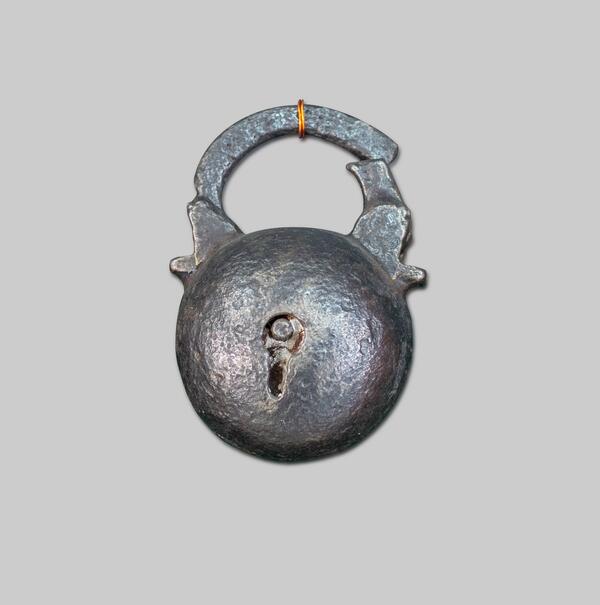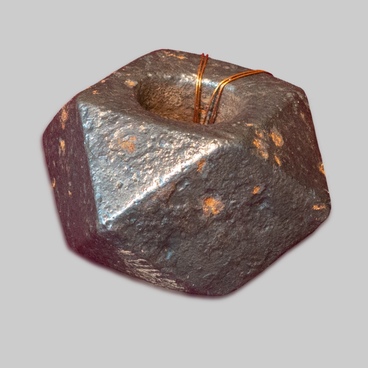A ball-shaped padlock is a very small size item. It is very likely to have been used for locking a chest or a travelling bag. It is assumed to have been imported from Western Europe. The padlock shackle is broken but certain parts of it have been preserved.
The first padlocks worked on the principle of stationary ones – they had several pins inside that kept the mechanism locked in down position. The key raised them to the required level, they released and opened the lock. Such technology was popular in the European countries.
The ancient padlocks had only one mechanism – a spring assembly, and on that principle all the subsequent locks were fabricated. When the key was inserted into the orifice, the spring was released and it dismissed the pad. That principle was used in the West until XIV century, and it is still popular in the East, namely, in China.
However the tradespeople and noblemen required better protection, and a spring type lock with a turning key was invented. To open such lock it was required not just to insert the key into the orifice but to turn it. Such mechanism could protect from the thieves who used lock picks. In the locks of the Renaissance the orifice and the lock latch were often hidden behind complicated armorial ornaments and exuberant drawing details.
Approximately at the same time there appeared vertical lock orifices. Certain locks fabricated to special order could only be opened with three or five keys simultaneously. In order to impede the access of strangers to the possessions, injuring fixtures were often fitted into the locks, like steel darts suddenly sticking into the hand of the intruder, or a pressing mechanism that could lame the fingers.
In 1778, an English designer Robert Barron invented a lever tumbler lock with several levers. Unlike the locks invented previously, it was much more reliable: in order to open such lock, all levers had to be lifted to a certain height.
By XIX century the locksmith’s trade developed rapidly, and there appeared padlocks with twisted-in keys. The relief of the key fully matched the wards inside the hull – it was impossible to open the lock otherwise. At the same time, “personalized” or “verbal” locks became popular. They had several cylinders with the letters to be used for putting together a password.
The first padlocks worked on the principle of stationary ones – they had several pins inside that kept the mechanism locked in down position. The key raised them to the required level, they released and opened the lock. Such technology was popular in the European countries.
The ancient padlocks had only one mechanism – a spring assembly, and on that principle all the subsequent locks were fabricated. When the key was inserted into the orifice, the spring was released and it dismissed the pad. That principle was used in the West until XIV century, and it is still popular in the East, namely, in China.
However the tradespeople and noblemen required better protection, and a spring type lock with a turning key was invented. To open such lock it was required not just to insert the key into the orifice but to turn it. Such mechanism could protect from the thieves who used lock picks. In the locks of the Renaissance the orifice and the lock latch were often hidden behind complicated armorial ornaments and exuberant drawing details.
Approximately at the same time there appeared vertical lock orifices. Certain locks fabricated to special order could only be opened with three or five keys simultaneously. In order to impede the access of strangers to the possessions, injuring fixtures were often fitted into the locks, like steel darts suddenly sticking into the hand of the intruder, or a pressing mechanism that could lame the fingers.
In 1778, an English designer Robert Barron invented a lever tumbler lock with several levers. Unlike the locks invented previously, it was much more reliable: in order to open such lock, all levers had to be lifted to a certain height.
By XIX century the locksmith’s trade developed rapidly, and there appeared padlocks with twisted-in keys. The relief of the key fully matched the wards inside the hull – it was impossible to open the lock otherwise. At the same time, “personalized” or “verbal” locks became popular. They had several cylinders with the letters to be used for putting together a password.



